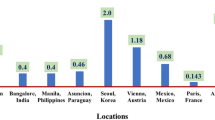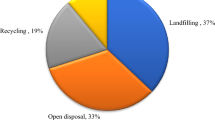Abstract
This research addresses the use of methane (CH4) for energy generation in a landfill located in Southern Mexico. To evaluate the feasibility of this renewable and sustainable energy project, a LandGEM model was used to estimate the CH4-emissions, the environmental benefits and the economic profitability. Taken together, results showed an average CH4-production of 2932 ft3/min, with a maximum CH4-generation flowrate of 4072 ft3/min (115.3 m3). Energy generation resulted in 32.396 million KW h/year with a hot water/steam production of 63.990 million BTU/year. The installed capital costs of a 15-years project were estimated in $9,034,907 USD; economic parameters showed a financial profitability with a net present value of $6,304,060 and an internal rate of return of 25%. The environmental benefits reported a total collection and destruction of CH4 at 9,824,469,979 ft3 (278,198,009.2 m3). The results obtained in this research can be used to conduct further studies to implement waste-to-energy technologies in Mexico and thus improve the sector of sustainable and renewable energy.

Similar content being viewed by others
References
Andres R, Fielding D, Marland G, Boden T, Kumar N, Kearney A (1999) Carbon dioxide emissions from fossil-fuel use, 1751–1950. Tellus B 51:759–765. https://doi.org/10.3402/tellusb.v51i4.16483
Owens S, Driffill L (2008) How to change attitudes and behaviours in the context of energy. Energy Policy 36:4412–4418. https://doi.org/10.1016/j.enpol.2008.09.031
Månsson A (2014) Energy, conflict and war: towards a conceptual framework. Energy Res Soc Sci 4:106–116. https://doi.org/10.1016/j.erss.2014.10.004
Shafiee S, Topal E (2009) When will fossil fuel reserves be diminished? Energy Policy 37:181–189. https://doi.org/10.1016/j.enpol.2008.08.016
Inman M (2013) The true cost of fossil fuels. Sci Am 308:58–61. https://doi.org/10.1038/scientificamerican0413-58
Klare M, (2013) Rushing for the Arctic’s riches. The New York Times, vol 7. https://www.nytimes.com/2013/12/08/opinion/sunday/rushing-for-the-arctics-riches.html. Accessed 5 Oct 2018
Schmidt C (2011) Arctic oil drilling plans raise environmental health concerns. Environ Health Perspect 119:116–117. https://doi.org/10.1289/ehp.119-a116
Alemán-Nava G, Casiano-Flores V, Cárdenas-Chávez D, Díaz-Chavez R, Scarlat N, Mahlknecht J, Dallemand J, Parra R (2014) Renewable energy research progress in Mexico: a review. Renew Sustain Energy Rev 32:140–153. https://doi.org/10.1016/j.rser.2014.01.004
SIE (2019) Sistema de Información Energética. Secretaría de Energía, Mexico. http://sie.energia.gob.mx/. Accessed 9 Jan 2019
Guerrero L, Maas G, Hogland W (2013) Solid waste management challenges for cities in developing countries. Waste Manag 33:220–232. https://doi.org/10.1016/j.wasman.2012.09.008
Marshall R, Farahbakhsh K (2013) Systems approaches to integrated solid waste management in developing countries. Waste Manag 33:988–1003. https://doi.org/10.1016/j.wasman.2012.12.023
Cancino-Solórzano Y, Paredes-Sánchez J, Gutiérrez-Trashorras A, Xiberta-Bernat J (2016) The development of renewable energy resources in the State of Veracruz, Mexico. Util Policy 39:1–4. https://doi.org/10.1016/j.jup.2016.01.001
Schneider P, Lämmel A, Schmitt A, Nam N (2017) Current and future solid waste management system in Northern Viet Nam with focus on Ha Noi: climate change effects and landfill management. J Mater Cycles Waste Manag 19:1106–1116. https://doi.org/10.1007/s10163-016-0551-7
Kaza S, Yao L, Bhada-Tata P, Van-Woerden F (2018) What a waste 2.0: a global snapshot of solid waste management to 2050. World Bank, Washington D.C.
Gómez G, Meneses M, Ballinas L, Castells F (2009) Seasonal characterization of municipal solid waste (MSW) in the city of Chihuahua, Mexico. Waste Manag 29:2018–2024. https://doi.org/10.1016/j.wasman.2009.02.006
Hernández B, Katsurada H, Alvarez M, García-Torres E, Sosa M (2013) Programa estatal para la prevención y gestión integral de los residuos sólidos urbanos y de manejo especial en el estado de Oaxaca. SEMAEDESO, Oaxaca
Nava-Uribe E, Juárez-López A, Sampedro-Rosas M (2015) Análisis comparativo de los residuos sólidos domésticos en localidades semirurales y rurales del estado de Guerrero, México. Tlamati 6:11–19. http://tlamati.uagro.mx/t63/t632.pdf. Accessed 20 Dec 2018
FAO (2016) Pérdidas y desperdicios de alimentos en América Latina y el Caribe. Oficina Regional de la FAO para América Latina y el Caribe, Panamá
Spokas K, Bogner J, Chanton J, Morcet M, Aran C, Graff C, Golvan Y, Hebe I (2006) Methane mass balance at three landfill sites: what is the efficiency of capture by gas collection systems? Waste Manag 26:516–525. https://doi.org/10.1016/j.wasman.2005.07.021
IPCC (2006) 2006 IPCC guidelines for national greenhouse gas inventories. Institute for Global Environmental Strategies. https://www.ipcc-nggip.iges.or.jp/public/2006gl/. Accessed 1 Jan 2019
Salomon K, Silva E (2009) Estimate of the electric energy generating potential for different sources of biogas in Brazil. Biomass Bioenergy 33:1101–1107. https://doi.org/10.1016/j.biombioe.2009.03.001
Münster M, Meibom P (2011) Optimization of use of waste in the future energy system. Energy 36:1612–1622. https://doi.org/10.1016/j.energy.2010.12.070
Brunner P, Rechberger H (2015) Waste to energy—key element for sustainable waste management. Waste Manag 37:3–12. https://doi.org/10.1016/j.wasman.2014.02.003
Bolan N, Thangarajan R, Seshadri B, Jena U, Das K, Wang H, Naidu R (2013) Landfills as a biorefinery to produce biomass and capture biogas. Biores Technol 135:578–587. https://doi.org/10.1016/j.biortech.2012.08.135
Zairi M, Aydi A, Dhia H (2014) Leachate generation and biogas energy recovery in the Jebel Chakir municipal solid waste landfill, Tunisia. J Mater Cycles Waste Manag 16:141–150. https://doi.org/10.1007/s10163-013-0164-3
Chun S (2017) Mechanism of hydrogen sulfide generation from a composite waste landfill site: a case study of the ‘Sudokwon Landfill Site’, Korea. J Mater Cycles Waste Manag 19:443–452. https://doi.org/10.1007/s10163-015-0441-4
Kumar S, Gaikwad S, Shekdar A, Kshirsagar P, Singh R (2004) Estimation method for national methane emission from solid waste landfills. Atmos Environ 38:3481–3487. https://doi.org/10.1016/j.atmosenv.2004.02.057
Amini H, Reinhart D, Mackie K (2012) Determination of first-order landfill gas modeling parameters and uncertainties. Waste Manag 32:305–316. https://doi.org/10.1016/j.wasman.2011.09.021
Scharff H, Jacobs J (2006) Applying guidance for methane emission estimation for landfills. Waste Manag 26:417–429. https://doi.org/10.1016/j.wasman.2005.11.015
Krause M, Chickering G, Townsend T (2016) Translating landfill methane generation parameters among first-order decay models. J Air Waste Manag Assoc 66:1084–1097. https://doi.org/10.1080/10962247.2016.1200158
EPA (2005) Landfill gas emissions model (LandGEM) version 3.02 user’s guide. Environmental Protection Agency, Washington D.C.
INEGI (2015) Número de habitantes: Oaxaca. Instituto Nacional de Estadística y Geografía. http://cuentame.inegi.org.mx/monografias/informacion/oax/poblacion/. Accessed 28 Nov 2018
INEGI (2016) Conociendo Oaxaca. Insituto Nacional de Estadística y Geografía, Ciudad de México
Jo J, Kim W (2018) Market potential of biomethane as alternative transportation fuel in South Korea. J Mater Cycles Waste Manag 20:864–876. https://doi.org/10.1007/s10163-017-0646-9
Fei F, Wen Z, De-Clercq D (2019) Spatio-temporal estimation of landfill gas energy potential: a case study in China. Renew Sustain Energy Rev 103:217–226. https://doi.org/10.1016/j.rser.2018.12.036
Ghosh P, Shah G, Chandra R, Sahota S, Kumar H, Vijay V, Thakur I (2019) Assessment of methane emissions and energy recovery potential from the municipal solid waste landfills of Delhi, India. Biores Technol 272:611–615. https://doi.org/10.1016/j.biortech.2018.10.069
Pillai J, Riverol C (2018) Estimation of gas emission and derived electrical power generation from landfills. Trinidad and Tobago as study case. Sustain Energy Technol Assess 29:139–146. https://doi.org/10.1016/j.seta.2018.08.004
Asadollahfardi G, Asadi M, Youssefi M, Elyasi S, Mirmohammadi M (2015) Experimental and mathematical study on ammonia emission from Kahrizak landfill and composting plants, Tehran, Iran. J Mater Cycles Waste Manag 17:350–358. https://doi.org/10.1007/s10163-014-0242-1
Mambeli R, Tiago G, Moreira A, Ferreira C, Fernandes M, Sales J, Sayuri H, Martins L, Silva I, Martuscelli E, Rocha J (2018) A potential of the biogas generating and energy recovering from municipal solid waste. Renew Energy Focus 25:4–16. https://doi.org/10.1016/j.ref.2018.02.001
Calabro P (2009) Greenhouse gases emission from municipal waste management: the role of separate collection. Waste Manag 29:2178–2187. https://doi.org/10.1016/j.wasman.2009.02.011
Escamilla-García P, Tavera-Cortés M, Pérez-Soto F (2019) Characterisation and calorific potential of waste generated in Mexico City for energy production. Int J Environ Waste Manag 23:123–140. https://doi.org/10.1504/IJEWM.2019.097611
CONAGUA (2018) Reporte del Clima en México. Comisión Nacional del Agua Mexico. https://smn.cna.gob.mx/tools/DATA/Climatolog%C3%ADa/Diagn%C3%B3stico%20Atmosf%C3%A9rico/Reporte%20del%20Clima%20en%20M%C3%A9xico/RC-Diciembre17.pdf. Accessed 15 Nov 2018
Mou Z, Scheutz C, Kjeldsen P (2015) Evaluating the methane generation rate constant (k value) of low-organic waste at Danish landfills. Waste Manag 35:170–176. https://doi.org/10.1016/j.wasman.2014.10.003
Escamilla-García P (2019) Efficiency and reliability of theoretical models of biogas for landfills. LA GRANJA Revista de Ciencias de la Vida 29:33–44. https://doi.org/10.17163/lgr.n29.2019.03
Papadias D, Ahmed S, Kumar R (2012) Fuel quality issues with biogas energy—an economic analysis for a stationary fuel cell system. Energy 44:257–277. https://doi.org/10.1016/j.energy.2012.06.031
Elwell A, Elsayed N, Kuhn J, Joseph B (2018) Design and analysis of siloxanes removal by adsorption from landfill gas for waste-to-energy processes. Waste Manag 73:189–196. https://doi.org/10.1016/j.wasman.2017.12.021
Secretariat of Environment and Natural Resources of Mexico (2016) Compromisos de mitigación y adaptación ante el cambio climático para el periodo 2020–2030. https://www.gob.mx/cms/uploads/attachment/file/162974/2015_indc_esp.pdf. Accessed 1 Feb 2019
INECC (2014) Inventario Nacional de Emisiones GEI. https://www.gob.mx/cms/uploads/attachment/file/110175/CGCCDBC_2015_Tabla_inventario_nacional_GEyCEI_2013.pdf. Accessed 3 Feb 2019
Escamilla-García P, Tavera-Cortés M, Sandoval-Gómez R, Salinas-Callejas E, Alvarado-Raya H (2016) Economic feasibility analysis for electrical generation from biogas in waste disposal sites in Mexico City. Appl Econ 48:5761–5771. https://doi.org/10.1080/00036846.2016.1184378
Pärssinen M, Wahlroos M, Manner J, Syeari S (2019) Waste heat from data centers: an investment analysis. Sustain Cities Soc 44:428–444. https://doi.org/10.1016/j.scs.2018.10.023
Pillai J, Riverol C (2018) Estimation of gas emission and derived electrical power generation from landfills. Trinidad and Tobago as study case. Sustain Energy Technol Assess 29:139–146. https://doi.org/10.1016/j.seta.2018.08.004
Asdrubali F, Ballarini I, Corrado V, Evangelisti L, Grazieschi G, Guattari C (2019) Energy and environmental payback times for an NZEB retrofit. Build Environ 147:461–472. https://doi.org/10.1016/j.buildenv.2018.10.047
SENER (2018) Programa de Desarrollo del Sistema Eléctrico Nacional. Secretaría de Energía. https://www.gob.mx/cms/uploads/attachment/file/331770/PRODESEN-2018-2032-definitiva.pdf. Accessed 14 Jan 2019
Tsai W (2016) Analysis of municipal solid waste incineration plants for promoting power generation efficiency in Taiwan. J Mater Cycles Waste Manag 18:393–398. https://doi.org/10.1007/s10163-014-0345-8
Fruergaard T, Christensen TH, Astrup T (2010) Energy recovery from waste incineration: assessing the importance of district heating networks. Waste Manag 30:1264–1272. https://doi.org/10.1016/j.wasman.2010.03.026
Author information
Authors and Affiliations
Corresponding author
Additional information
Publisher's Note
Springer Nature remains neutral with regard to jurisdictional claims in published maps and institutional affiliations.
Rights and permissions
About this article
Cite this article
Escamilla-García, P.E., Jiménez-Castañeda, M.E., Fernández-Rodríguez, E. et al. Feasibility of energy generation by methane emissions from a landfill in southern Mexico. J Mater Cycles Waste Manag 22, 295–303 (2020). https://doi.org/10.1007/s10163-019-00940-3
Received:
Accepted:
Published:
Issue Date:
DOI: https://doi.org/10.1007/s10163-019-00940-3




